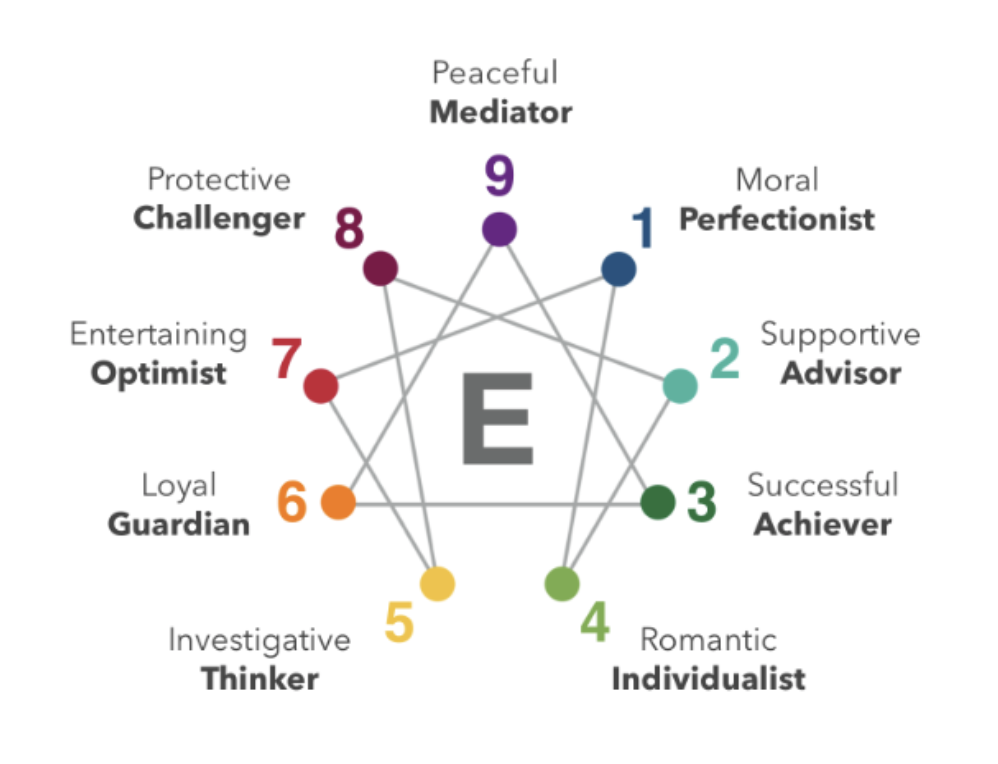Thursday, February 25 found fourteen of our fellow Eastern community members gathered around Zoom to learn something that might help them through this pandemic. Christyn Riehl, Assistant Director of the Center for Career Development and Dr. Lisa Hemlick, Director of the Cushing Center for Counseling and Academic Support, were excited to share their knowledge of an ancient system of self-understanding, known as the Enneagram.
Riehl was first introduced to the Enneagram as an RA while at Eastern, and described enjoying it as “a way to see what’s going on underneath the surface, to focus on growth and change, to avoid creating excuses for oneself.”
Dr. Hemlick discovered the Enneagram in her doctoral training and found it very helpful in learning how to do therapy and counseling. “It’s not about absolute truth,” Hemlick said, but rather “a useful tool which can help show individuals’ different motivations for external behaviors.”
What are they so excited about? The Enneagram is a personality test, based on Enneagram personality theory, which describes personality in terms of nine types, each driven by their own core set of fears, desires, and beliefs. According to www.integrative9.com, “the roots of the Enneagram are disputed and unclear, but seem connected to different spiritual and oral traditions as well as specific mathematical and philosophical traditions.”
Among many possible sources are “sacred geometry of Pythagorean mathematicians,” “Plotinus, in the Enneads,” esoteric Judaism (through philosopher Philo), Sufi traditions, and early medieval notions of Christianity and the seven deadly sins. Its current shape took form based on work by Gurdjieff, Russian mystic and teacher of the 1920s, South American scholar Oscar Ichazo (working in the 1960s), and Chilean psychiatrist Claudio Naranjo. As it made its way into the world of psychology the Enneagram was “partially validated through experiential and empirical studies,” leading to greater acceptance.
Many are already familiar with the enigmatic Enneagram circle, wherein each type is indicated by a number 1 through 9, connected in various directions with lines forming a sort of star. As Riehl explained, there is no hierarchy to the numbers, and each has been assigned a name summarizing its main characteristics.
Type 1 is known as the Reformer/Perfectionist, with a basic fear of being bad or corrupt, a basic desire to be good and have integrity, driven by the belief “You are good/okay if you do what is right.”
Type 2, the Giver/Helper, fears being unwanted or unworthy of love, desires to feel loved, and believes “You are good/okay if you are loved by others and close to them.”
Type 3, Performer/Achiever fears being worthless or without value, longs to feel and be seen as worthwhile, accepted or desirable, believes “You are good/okay as long as you are successful and others think well of you.”
Type 4, Individualist/Romantic worries about having no identity or personal significance, seeks to find their authentic selves and their significance, believes “You are good/okay if you are true to yourself.”
Type 5, Observer/Investigator fears being helpless, useless or incapable, wants to be seen as capable and competent, believes “You are good/okay if you have mastered something.”
Type 6, Loyalist/Skeptic fears having no support or guidance, is driven to find security and support, believes “You are good/okay if you do what’s expected of you.”
Type 7, Enthusiast/Epicure fears being deprived or in pain, longs to be happy, satisfied and find fulfillment, believes “You are good/okay if you get what you need.”
Type 8, Protector/Challenger fears being harmed or controlled by others, desires to protect themselves and determine their own course in life, believes “You are good/okay if you are strong and in control of your situation.”
And Type 9, Mediator/Peacemaker fears loss and separation, desires to maintain inner stability and peace of mind, and believes “ You are good/okay as long as those around you are good/okay.”
As Riehl explained, this is only scratching the surface of what can be gleaned from a thorough understanding of the Enneagram. She recommended several helpful websites, including The Enneagram Institute and 9types.com, which have arisen along with the Enneagram’s growing popularity.

